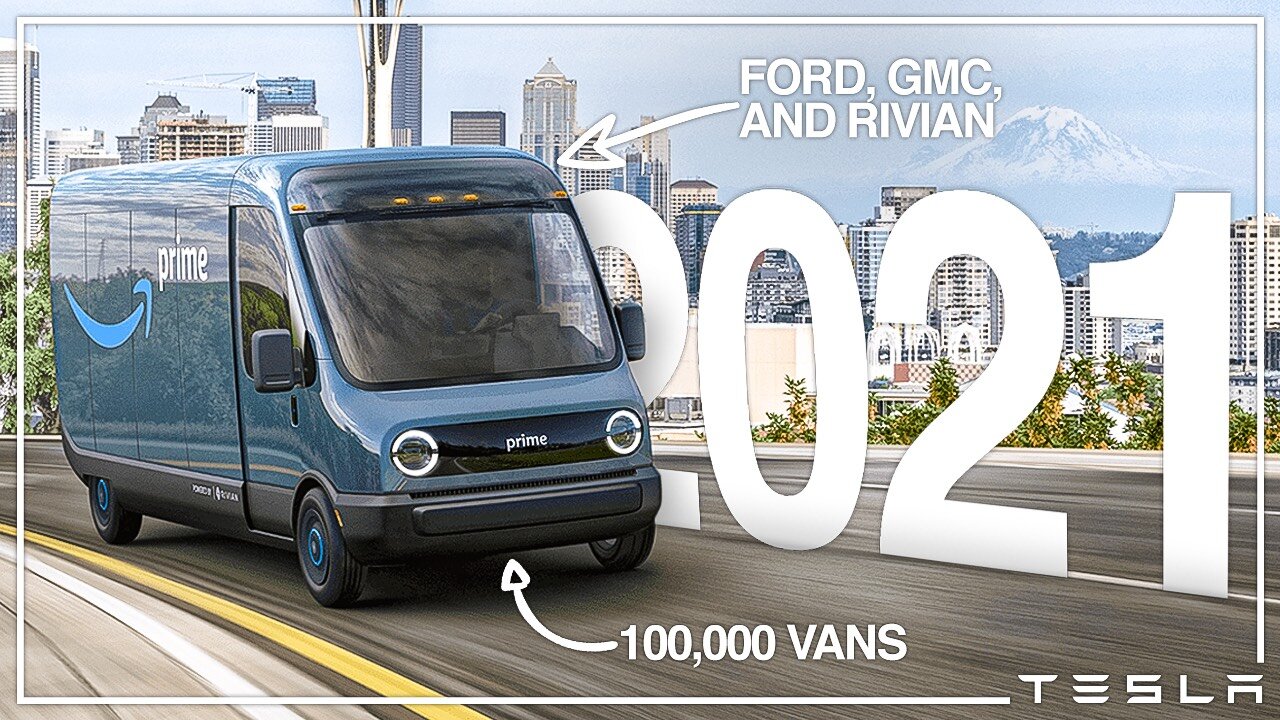The Electric Van Competition Update
We often hear that the impact made on the environment by individuals is basically insignificant compared to the impact created by large corporations. Basically, if you and I both buy electric cars, that’s great!. But it does not put a dent in the big picture of carbon pollution. As long as we have Amazon and FedEx driving around fleets of large, fuel burning delivery trucks all day, every day - we’re going to have a problem with vehicle pollution. Now what if those corporations came over to our side and started buying electric vehicles along with us? Then we could start to make a difference, we make that dent in the carbon footprint. And lucky for us right now, this is starting to happen. It’s been frustratingly slow to get started, but the groundwork has been set and we’re on the way. So that’s what we’re talking about in the video today, the upcoming electric van market from the Rivian Prime to the GM Brightdrop and a couple points in between.
We don’t always talk exclusively about Tesla on this channel and they can’t be everything to everyone. So it can be fun to branch out into some EV related topics that involve other brands, like with electric vans. I don’t believe in hating on every brand that isn’t Tesla, it gets boring quick.
Rivian Prime Van
We start with Rivian because they scored the holy grail of delivery truck contracts with Amazon. Say what you will about Jeff Bezos and the company he founded, they’re problematic to say the least and I’ve talked plenty of shit about Jeff on this channel, but when the opportunity comes up to work with a company of this size, any reasonable business person would take it, myself included.
Rivian is a California based EV startup that was founded in 2009. They have a pretty solid mission statement, Founder and CEO RJ Scaringe says that Rivian's purpose is to deliver products that the world didn't already have. They built up the company very quietly, developing products, buying a factory, building a team of engineers and securing funding from low key investors. In 2018 they debuted their R1 series of pickup truck and SUV, positioning themselves as an EV brand for the outdoor loving, adventurous type.
In September 2019, Rivian inked a 700 million dollar deal to deliver 100,000 Amazon Prime delivery trucks by the year 2030. The first 10 thousand of those trucks will be on the road in 2022.
The first thing you’ll probably notice about the Rivian Prime Van is that it kinda looks like a cartoon character, like it has a face and personality. That was done very much on purpose. When Amazon and Rivian were choosing the final design of the van, their top priority was that it looked “friendly”. Pretty much the opposite of those flat faced, hard edged FedEx trucks that make you scared to cross the street in front of them. It makes a whole lot of sense from a branding perspective for Amazon. Why not have a delivery truck that basically does double duty as a brand mascot?
The Prime Van is being built on the same skateboard platform as the Rivian R1 series. That means the basic electrical and network architecture, ECUs, and battery packs will be the same across all Rivian vehicles. The van’s single-motor e-axle drive units come from the entry-level version of the R1. But there's enough difference between these skateboards that they will be assembled on their own line, separate from the R1. The body build and final assembly will also occur on a separate "low-feature-content" assembly line, though common body and paint shops will handle both.
That one frame will be stretched out and resized to accommodate the three sizes of Prime Van on order, either 500, 700 or 900 cubic feet. The smallest one is more narrow than the larger two and has about as much room as the mainstream Mercedes-Benz Sprinter or Ford Transit delivery vans.
The battery pack will be the same in all 3 variations, and it’s rated at 150 miles of range. Rivian doesn’t specify which size of van that rating applies to, but logistically, it doesn’t really matter. Remember, these vans are designed for what they call “last mile” service. So they’ll only ever be driving straight from local distribution centres to delivery locations. And according to Amazon, the bigger and more full a truck is, the fewer miles it tends to travel. They’d primarily be using the largest trucks in very densely populated, metropolitan areas, like say Manhattan for example. Amazon says that a fully laden delivery truck in New York City will often travel just 10 miles or less in one shift - so in those kinds of situations, range just doesn’t matter.
On top of the EV tech, Rivian is putting in effort with this van to make life easier for the people who will be driving them. They’re working on maximizing ergonomics with the design and position of work essentials like the steps and assist handles. Heated and cooled seats and heated armrests boost the driver's comfort level while reducing the need to fully heat all the air in the large front compartment - especially when the sliding passenger door has to open and close frequently. The windshield is defrosted via a grid of tiny wires like what you would have on your rear window, which is more efficient than blowing hot air on it. As Rivian CEO RJ Scaringe points out, while most product-planning departments have to guess the wants and needs of their end-users, Rivian was able to speak directly with thousands of veteran Amazon drivers to determine precisely what would help make their jobs easier and more rewarding. Of course, I’m sure their number one request was to have actual bathroom breaks instead of piss jugs. But at least someone is making an effort to do better.
Here’s a crazy feature that might be coming eventually. Rivian has been working on a design that would allow a drone to take off through the roof of the van, carrying a package to the doorstep. That feature is not expected to arrive in any of the first 100 thousand vans.
Ford E-Transit
Next up is the brand new electric delivery van from Ford Motors. The Ford Econoline van has been an icon since the 1960’s, selling over 10 million units over the decades, and for 2022 that lineage evolves again into the all electric E-Transit Van.
Unlike the cartoon Rivian, the Ford is going to look pretty much identical to the typical delivery van. There isn’t much that would identify it as an electric vehicle, it even retains the grill design, which is completely useless on an EV.
The standard E-Transit will have one motor and rear wheel drive. The van is said to use many of the same parts as the Ford Mustang Mach-E, including the same 266 horsepower motor and 68 kilowatt hour battery pack as the base model Mach-E. In the Mustang, that’s good for 230 miles of range, but transplanted into the much bigger and less aerodynamic Transit Van, the range comes down to just 126 miles. Much like with Rivian and Amazon, that sounds low but it’s not really a big deal for the real world applications of these commercial vans. Ford leveraged more than 30 million miles of Telematics data, and learned that the average daily range for commercial vans in the U.S. is 74 miles. Of course they also factor in days when those distances are higher, and recognize the need to adjust for factors such as cold weather. So according to the data, Ford is pretty confident that 126 miles should be enough for a day’s work.
Much like the Ford F150 Lightning, the E-Transit will be able to function basically the same as an electric generator to help out on job sites. The onboard plugs will output enough power to charge drill batteries or run a table saw without the need for an inverter.
These should be on the road by the end of this year with a starting price of just 45 thousand US dollars, pretty sweet deal.
GM BrightDrop
Getting back to EVs scoring big time corporate contracts, General Motors have teamed up with FedEx to create the BrightDrop line of electric delivery vehicles. BrightDrop isn’t just the name of the van, it’s a whole new brand that has been established under the GM umbrella, just like Chevrolet, Cadillac and Buick. BrightDrop will focus on offering a full ecosystem of connected electric products, software, and services to delivery and logistics companies such as FedEx.
The flagship product is going to be the EV600 van. These offer the most impressive spec sheet out of any of the delivery options we’ve looked at so far. The EV600 will offer up 600 cubic feet of storage space while managing a very impressive 250 miles of range.
The electric van is going to be coming with it’s very own robotic helper, the EP1 electric palette from BrightDrop. This basically looks like a big rolling suitcase that’s almost as tall as an average human. The robot cabinet opens up to reveal adjustable shelves for parcels, offering 23 cubic feet of cargo space that can handle a payload of 200 pounds. The EP1 has a built-in electric hub motor, which allows it to travel as fast as 3 miles per hour. FedEx said the electric pallets used in the pilot project allowed them to handle 25 percent more packages per day.
GM is supposed to begin manufacturing the EV600 this year, with the first batch of 500 vans going straight to FedEx. Starting next year, these should be open to purchase for anyone who can afford them. No word yet on retail price, but they look pretty damn expensive.


